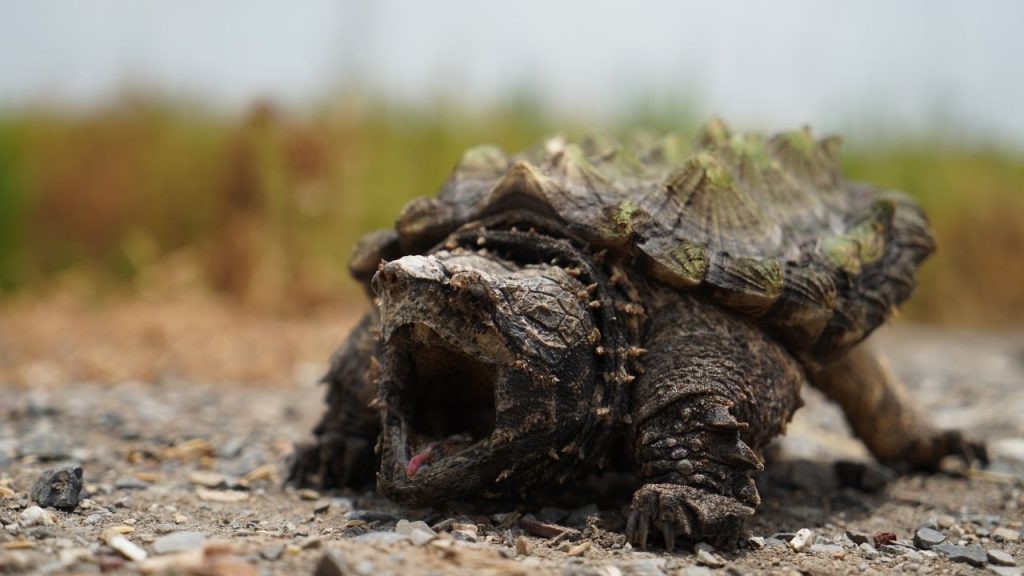Tags:
How Long Do Snapping Turtles Live? [Explained With Chart]


fact checked & review by
Dr. Partho Kumar Shaha
Veterinarian (DVM)
The information is current and up-to-date in accordance with the latest veterinarian research.
Snapping turtles live long, at least longer than most dog or cat breeds. People often doubt whether to commit for all those years or not. I prefer researching the lifespan of any turtle species before welcoming the pet home. It helps me plan out for the turtle, both financially and mentally.
The common snapping turtles live around 50 years in captivity. On the other hand, the lifespan of alligator snapping turtles is about 70 years as pets.
The wild snapping turtles generally live a shorter life compared to the captive ones. Do you know why? The following article answers all your questions regarding the longevity of the snapping turtle. Read to the end and do not forget to check out the additional tips to increase the life expectancy of your pet turtle.
How Long Do Snapping Turtles Live?
Snapping turtles are undoubtedly blessed with a long life. The species has two subspecies, each with unique features. The differences between them reflect in their life expectancy too.
While the monstrous-looking alligator snapping turtles might live a century, the common snapping turtles hardly cross the 50. The physique, genetics, and biological needs are responsible for this difference.
Lifespan Chart Of Snapping Turtles,
| Snapping Turtle | Average Lifespan (in the wild) | Average Lifespan (in captivity) |
|---|---|---|
| Common Snapping Turtle | 30 years | 50 years |
| Alligator Snapping Turtle | 45 years | 70 years |
See, the alligator snapping turtles have a longer life expectancy than the common snapping turtles. Again, the wild turtles may not live as long as the captive ones.

How Long Can A Common Snapping Turtle Live?
A common snapping turtle lives around 30 to 50 years. According to a report, the oldest common snapping turtle ever recorded in captivity was 47 years old.
You know, the pet common snapping turtles have a longer lifespan than wild ones. While the wild turtles struggle to cross their 30s, the captive ones might reach 50 years old.
Some owners claim their common snapping turtles to live about 75 years. Though there is not enough verified evidence of such incidents, you can not ignore the possibilities.
A common snapping turtle grows 22 inches in length and can reach 34 kgs in weight. These turtles experience fast growth in the first few years of their life. They gain sexual maturity at the age of 15 to 20, and the growth somehow freezes after this phase.
How Long Can An Alligator Snapping Turtle Live?
An alligator snapping turtle has a life expectancy of 45 to 70 years, depending on the breed. A wild alligator snapping turtle lives for 45 years+, while a captive-bred turtle’s longevity is 70 years or more.
The alligator snapping turtles are one of the longest-living turtles. Though the life longevity of these turtles is considered 70 years, they can live 80 to 120 years in general, even in the wild.
Travis Thomas, a researcher, caught a monstrous alligator snapping turtle in 2012. After thorough research, the Florida Fish And Wildlife Conservation Commission concluded that the wild-caught turtle was around 80 years old. The creature was in good health and good to go for a few more decades.
In 2014, another 80-year-old alligator snapping turtle was trapped in New River, North of Gainesville.
There are several reports that prove that alligator snapping turtles can live for a century in both wild and captivity. Some experts claim that these turtles can live for two centuries.
Alligator snapping turtles have a bulky body and reach 32 inches in length. When it comes to weight, they can go up to 113 kgs or more.
These alligator snapping turtles experience fast growth in the first few years, like the common snapping turtles. Their body development rate slows down once they hit maturity, at the age of 12.
Why Do Captive Snapping Turtles Live Longer?
You already know that pet snapping turtles enjoy a longer and healthier life. The fact more or less works for all turtle species.
Why do you think wild turtles have a shorter lifespan? When I asked around and researched, I came across 3 factors that somehow affect the life expectancy of turtles. Such as,
- Environment
- Diet
- Health
Environment
The surroundings have a significant role in deciding how long your snapping turtle will live. Imagine a turtle living in a narrow space with too hot or cold temperature. What will happen?
The pet will go through mental stress and physical discomfort. Soon, the turtle will exhibit different symptoms of diseases. You already know any severe health complexities deduct years from the life shelf.
We, as turtle lovers, try our best to replicate the wild environment in captivity. For example, we set up a basking dock, UV light, heating lamps, water filter, water heater, and other equipment to keep the turtle feel at home. Still, if we miss out on providing the suitable temperature and humidity range, the pet is at the risk of falling sick.
In the wild, snapping turtles get everything natural. Hence, they should have a long life there. Right?
Well, you are absolutely right, and in many cases, the wild snapping turtles live more than 100 years or up to 200 years. But the real dangers out there are the winters and the predators.
In several states in the USA, the winter is unbearable. The snapping turtles struggle to survive those seasons.
Again, the attack of predators can damage the turtle shells and skins, which might lead to deadly infections. These are the reasons why wild turtles do not enjoy a long lifespan.
Diet
What if you do not get a balanced meal to eat? Of course, you will suffer from mineral deficiency and develop a weak immunity. The same thing happens with a snapping turtle.
Like humans, snapping turtles require a nutritious diet to lead a healthy and balanced life. Otherwise, the pet will fall victim to diseases like hypovitaminosis, MBD, respiratory illness, etc.
While in captivity, a snapping turtle gets enough food to eat. Let it be summer or winter. The owners feed the pet a full stomach. Not only that, they sprinkle the meals with necessary supplements to avoid the risk of mineral deficiency.
On the other hand, the wild snapping turtles struggle to find their meals. So, mineral deficiency seems common among them.
The lack of nutrients means a poor immunity system that the turtles are more vulnerable to diseases. Hence, poor diet works as a factor that pushes the wild snapping turtles to a shorter life.
Health
After environment and diet, something that affects a snapping turtle’s lifespan is its health care.
Turtles will fall sick very often. How fast they are getting medical attention is the factor that affects their longevity.
In the wild, snapping turtles are on their own. They have to suffer even when they are severely ill. Many turtles die a pre-mature death as clinical support is out of reach.
On the other hand, captive snapping turtles get medical care really fast. Most owners note down the behavior, food habit, and activity hours of the pets regularly. So, if anything goes south, they act immediately. Moreover, almost all turtle keepers maintain the once or twice a year health check-up rule.
As the pet snapping turtles have access to quality medical attention, they tend to live a better and longer life.

Can Snapping Turtles Live 100 Years?
A snapping turtle can definitely live 100 years and even more. Till now, the oldest living snapping turtle was 150 years old. Experts believe these turtles can live up to 200 years.
Snapping turtles have two subspecies, common snapping turtle and alligator snapping turtle. While the alligator snapping turtles have a long lifespan, the common snappers have medium longevity.
Generally, a common snapping turtle lives 50 to 75 years in captivity and 30 years in the wild. On the other hand, the alligator snapping turtles enjoy a 70 years lifespan as pets, and the range can go up to 120 years.
In the wild, the subspecies generally live more than 45 years, according to the record. But professionals believe that they can live up to 200 years in rivers, uncared.
How Old Is The World’s Oldest Snapping Turtle?
Thunder was the world’s oldest snapping turtle. She passed away in 2016 at the age of 150.
Alligator snapping turtles are long-living creatures, and Thunder also belonged to the subspecies. Researchers found her in the 1990s near a seafood market in Louisiana. After that, the scientists moved her to a farm in Missouri. Then they transferred Thunder to Newport Aquarium near Cincinnati for observation purposes.
It is rare to find an alligator snapping turtle as big and old as Thunder. The natural and synthetic factors are responsible for this. If the black market keeps growing and habitat destruction does not stop, snapping turtles will soon be pushed towards extinction.
How Can You Tell How Old A Snapping Turtle Is?
To tell the exact age of a snapping turtle, you have to count down the days from its hatching date. Besides, growth ring counting, comparing the growth with a standard chart, and observing the carapace are popular methods of determining a snapping turtle’s age.
It is nearly impossible to calculate the exact age of a snapping turtle unless you know when it was hatched. The whole process gets more complicated for a mature, old, and advanced-aged snapping turtle.
However, there are ways to make an educated guess at the snapping turtle’s age. Of course, you can not say the estimated age is 100% accurate. But in most cases, you can rely on the result.
Generally, we practice 3 tricks while determining the age of a snapping turtle. Such as,
- Counting Annuli Rings
- Carapace Growth
- Shell Appearance
Counting Annuli Rings
When we were a child, our teachers taught us to determine the age of a tree by counting down its rings. We will apply the same technique to estimate how old your snapping turtle is.
Scientists have noticed that snapping turtles form growth rings the same way trees do. Each scute on the carapace carries these rings.
Now, the thickness and visibility of these rings depend on the turtle’s growth. For example, if the creature has access to plentiful resources, the circle will mature. On the other hand, the turtle grows slowly when there is scarce food.
For the first event, the rings will be thick and visible. But for the latter, the circle will be pale and thin.
Usually, the thicker rings are developed during summer seasons when the turtle can hunt and gather meals. Again, the creature hibernates or survives with a small portion of food in the winter. Hence, the growth ring is pale and narrower.
The thick and narrower rings take one year to develop. So, you can say that each growth ring pair corresponds to one year. Scientists have grabbed this chance and converted it into the age estimation method for snapping turtles.
Here is what you have to do,
- Take an individual scute of the snapping turtle on the carapace.
- Count all the rings located within the scute.
- Divide the number by two.
- Voila! You have got the closer age of your pet turtle.
Carapace Growth
Another factor that might help determine your snapping turtle’s age is its body growth. Generally, these turtles are 1.5 inches and weigh around a few ounces when they are born. The babies will grow a carapace of 12 inches once they gain sexual maturity.
After that phase, the growth of a snapping turtle slows down but not completely. A 50 years old snapping turtle might have a carapace length of 26 inches with a 64 pounds body weight. The creature can grow even after its carapace growth freezes.
Take a quick look at the chart growth chart of a snapping turtle,
| Age | Carapace Length | Weight |
|---|---|---|
| Hatchlings | 1.5 inches | few ounces |
| 1 year | 2.5 to 4 inches | 1 to 2 pounds |
| 2 years | 5 to 6 inches | — |
| 3 years | 6 to 8 inches | — |
| 5 years old | 8 to 10 inches | — |
| 10 years old | 10 to 12 inches | 10 to 35 pounds |
| 15 to 20 | 12 to 16 inches | 35 pounds++ |
| 40 years old | 16 to 26 inches++ | 46 pounds (female) |
| 50 years old | 16 to 26 inches++ | 64 pounds |
| 80 years old | 16 to 26 inches++ | 100 pounds |
| 100 years old | 16 to 26 inches++ | 125 to 175 pounds (male) |
However, this method is not accurate either. A snapping turtle might experience faster or slower growth depending on its genetics, environment, and care level.
Shell Appearance
The shell appearance often indicates the age group of a snapping turtle. For example, the baby snapping turtles have ridges running down at the center of the carapace. With time, these keels disappear, and the turtles get a smooth top shell. Again, the hatchlings also have white dots on their carapace, which vanish with age.
See, none of these characteristics can help you determine the exact age of the turtle. But at least you can guess its age group.
How To Ensure A Long Lifespan Of A Snapping Turtle?
Snapping turtles usually live a long and adventurous life. Sometimes, disease or accident might steal years from their lifespan. As a responsible owner, you should be prepared to handle any unexpected events coming your way.
Here are a few tips that might help your turtle enjoy a risk-free and long life,
- While shopping for the snapping turtle, check its health thoroughly. If you take an ill turtle home, chances are it will not survive longer. Moreover, the pet might make other turtles sick.
- Snapping turtles have a bulky appearance, and they require a spacious enclosure. Make sure the pet can move and swim freely in the habitat.
- You have to install several types of equipment for the comfortable living of the snapping turtles, for example, basking dock, lights, tank filter, water heater, etc.
- Maintaining a suitable temperature and humidity level in the enclosure is a must. Too hot or too cold temperature exposes the turtle to diseases.
- Feed the snapping turtle a nutritious diet with a sprinkle of supplements. The species is omnivorous. So, prepare the meals balancing between the animal and plant matter.
- A regular health checkup benefits you in treating the snapping turtle and preventing any severe disease.
- Snapping turtles hate tank mates or constant handling. Frequent touch frustrates these pets, and snapping turtles might bite the opponent while panicked. Hence, handle the turtles following proper guidelines.
Conclusion
Snapping turtles live a pretty long life, and the longevity increases if you provide them good care. Proper habitat, a balanced diet, and instant medical attention can make these pets enjoy a longer lifespan.

About Author
Muntaseer Rahman started keeping pet turtles back in 2013. He also owns the largest Turtle & Tortoise Facebook community in Bangladesh. These days he is mostly active on Facebook.
Disclaimer
This site is owned and operated by Muntaseer Rahman. TheTurtleHub.com is a participant in the Amazon Services LLC Associates Program, an affiliate advertising program designed to provide a means for sites to earn advertising fees by advertising and linking to Amazon.com. This site also participates in other affiliate programs and is compensated for referring traffic and business to these companies.
